
One of the most controversial elements of the Iwo Jima invasion was the extent of the pre-landing bombardment. Marine commanders, whose previous experience had made them painfully aware that considerable time was necessary to find and destroy often-well-hidden Japanese defensive positions, had requested ten days of preliminary shelling. Fifth Fleet commander Admiral Raymond A. Spruance, who had overall responsibility for the operation, knew that time and ammunition supply did not permit such a long bombardment, and also believed, incorrectly, that months of constant attacks by long-range bombers had degraded enemy defenses. He accordingly allowed only three days for the task, and stuck to that allotment despite the Marines' pleas for more.
Unfortunately, weather greatly reduced the effectiveness of the first day's bombardment. When Rear Admiral William H.P. Blandy's Task Force 54 arrived off Iwo Jima on 16 February 1945, ready to begin shelling, rain and low visibility made effective gunfire control nearly impossible. Though six battleships (Arkansas, New York, Texas, Nevada, Idaho and Tennessee), five cruisers (Pensacola, Salt Lake City, Chester, Tuscaloosa and Vicksburg) and many destroyers were present and shooting, at the end of the day results were modest, at best.
Visibility, and bombardment effectiveness, greatly improved during the following two days. The task was assisted by occasional Japanese efforts to return fire, which pointed out the location of previously concealed pillboxes and other defenses. Ships worked closer to shore, enhancing accuracy, and more targets became apparent as their cover was blasted away. However, at least 700 fortified positions had been identified, and all could not be dealt with in the remaining time. On 18 February fire was therefore concentrated on the landing beach areas and the adjacent heights.
On the morning of "D-Day", 19 February, the bombardment intensified. Two more battleships (North Carolina and Washington -- a third, West Virginia, arrived later in the day) added sixteen inch shells to the fourteen and twelve inch types of the battleships already on station. Three additional cruisers (Indianapolis, Santa Fe and Biloxi) brought more eight and six inch guns to the battle. Heavy ships stood off Iwo Jima's southeastern and southwestern coasts, many of them placed to inflict a close-in battering on the enemy. Rates of fire were increased, with periodic lulls to allow carrier-based airplanes to add their bombs, rockets and machine gun bullets to the attack. The lower half of the island appeared to be receiving an overwhelming rain of fire.
While this massive weight of ordnance, and that delivered on the previous days, greatly reduced Japanese defensive power, especially on and behind the landing beaches, much remained, and the enemy garrison was very well sheltered in deep caves and bunkers. As two divisions of U.S. Marines began to come ashore, these soon revealed themselves in a deadly barrage of artillery, mortars and automatic weapons fire. Inland from the beaches, on Mount Suribachi to the south, and in the rugged terrain to the north, even more tough defenses survived. These would have to be overcome before the island was ready to play its assigned role in the assault on Japan's home islands.
This page features, and provides links to, all the views
we have showing bombardment and other preparatory activities off
Iwo Jima, prior to the 19 February 1945 landings.
For more images of Iwo Jima bombardment and other pre-landing preparations, see::
For other pictures concerning the Iwo Jima Operation, see:
| If you want higher resolution reproductions than the Online Library's digital images, see: "How to Obtain Photographic Reproductions." |
Click on the small photograph to prompt a larger view of the same image.
|
Photo #: 80-G-308952 USS New York (BB-34) Bombarding Japanese defenses on Iwo Jima, 16 February 1945. She has just fired the left-hand 14"/45 gun of Number Four turret. View looks aft, on the starboard side. Official U.S. Navy Photograph, now in the collections of the National Archives. Online Image: 63KB; 740 x 605 pixels Reproductions of this image may also be available through the National Archives photographic reproduction system. |
 |
|
Photo #: 80-G-303866 Iwo Jima Operation, 1945 USS Texas (BB-35) underway off Iwo Jima during the landings there in February 1945. USS LSM-266 is in the right background. Photographed from USS Nevada (BB-36). Official U.S. Navy Photograph, now in the collections of the National Archives. Online Image: 85KB; 740 x 615 pixels Reproductions of this image may also be available through the National Archives photographic reproduction system. |
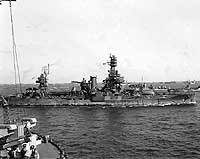 |
|
Photo #: 80-G-K-3510 (Color) Iwo Jima Operation, 1945 USS Nevada (BB-36) bombarding Iwo Jima, 19 February 1945. A North Carolina class battleship (probably USS Washington, BB-56) is in the left distance. Official U.S. Navy Photograph, now in the collections of the National Archives. Online Image: 59KB; 740 x 605 pixels Reproductions of this image may also be available through the National Archives photographic reproduction system. |
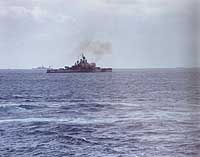 |
|
Photo #: 80-G-K-3510 (cropped) (Color) USS Nevada (BB-36) Bombarding Iwo Jima, 19 February 1945. This image is cropped from Photo #: 80-G-K-3510 to emphasize Nevada's camouflage pattern. Official U.S. Navy Photograph, now in the collections of the National Archives. Online Image: 42KB; 740 x 575 pixels Reproductions of this image may also be available through the National Archives photographic reproduction system. |
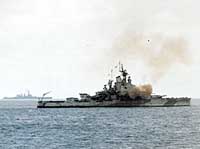 |
|
Photo #: 80-G-303822 Iwo Jima Operation, 1945 USS Idaho (BB-42) bombarding Iwo Jima, prior to the landings there, circa 16-19 February 1945. Heavy cruiser in the right distance is probably USS Chester (CA-27). Photographed from USS Nevada (BB-36). Official U.S. Navy Photograph, now in the collections of the National Archives. Online Image: 55KB; 740 x 615 pixels Reproductions of this image may also be available through the National Archives photographic reproduction system. |
 |
|
Photo #: NH 44724 USS North Carolina (BB-55) Off Iwo Jima while supporting the invasion of that island, circa 19-22 February 1945. Three cruisers and the battleship Idaho are in the background, with Iwo Jima beyond. Mount Suribachi is in the far left. U.S. Naval Historical Center Photograph. Online Image: 58KB; 700 x 675 pixels |
 |
|
Photo #: NH 44725 USS North Carolina (BB-55) Firing her forward sixteen-inch guns while bombarding Iwo Jima, circa 19-22 February 1945. U.S. Naval Historical Center Photograph. Online Image: 54KB; 650 x 675 pixels |
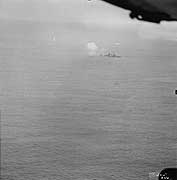 |
|
Photo #: NH 44726 USS Washington (BB-56) Off Iwo Jima while supporting the invasion of that island, circa 19-22 February 1945. U.S. Naval Historical Center Photograph. Online Image: 47KB; 640 x 675 pixels |
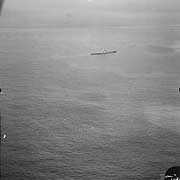 |
|
Photo #: 80-G-309140 Iwo Jima Operation, 1945 USS Texas (BB-35) recovers a Vought OS2U "Kingfisher" floatplane in a light rain at 1700 Hrs. on 16 February 1945, the first day of the Iwo Jima pre-invasion bombardment. The OS2U's radioman is riding the wing after hooking the plane to the recovery crane. Note details of the crane, aircraft recovery mat and net, 40mm quad gun mounting and the plane's color scheme and markings. Official U.S. Navy Photograph, now in the collections of the National Archives. Online Image: 72KB; 740 x 610 pixels Reproductions of this image may also be available through the National Archives photographic reproduction system. |
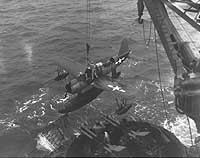 |
For more images of Iwo Jima bombardment and other pre-landing preparations, see::
For other pictures concerning the Iwo Jima Operation, see:
| If you want higher resolution reproductions than the Online Library's digital images, see: "How to Obtain Photographic Reproductions." |
Page made 31 December 2006
New image added 18 June 2007